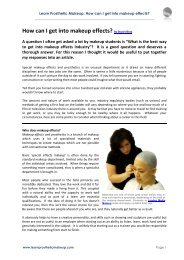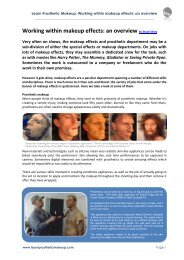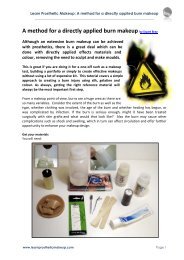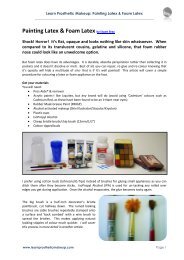Painting Foam Latex by Stuart Bray - Learn Prosthetic Makeup
Painting Foam Latex by Stuart Bray - Learn Prosthetic Makeup
Painting Foam Latex by Stuart Bray - Learn Prosthetic Makeup
Create successful ePaper yourself
Turn your PDF publications into a flip-book with our unique Google optimized e-Paper software.
<strong>Learn</strong> <strong>Prosthetic</strong> <strong>Makeup</strong>: <strong>Painting</strong> <strong>Foam</strong> <strong>Latex</strong><br />
________________________________________________________________<br />
Stage 1: The appliance glued in place using the Pros-Aide®, edges worked a little with<br />
IPA alcohol. Give the whole appliance a coat of Pros-Aide® thinned with a little<br />
water. This seals the foam and prevents any paint soaking into the foam-after all it is<br />
essentially a latex sponge. Dry carefully with a hairdryer, powdering as soon as it is<br />
dry. Pros-Aide® glue remains shiny and tacky when dry, so ensure you powder<br />
before any facial expressions are pulled as everything that touches will stick. If this<br />
happens, a little IPA on a brush or cotton bud will un-tack it.<br />
Stage 2: On with the first coat of PAX paint (thinned with water), blended into the<br />
skin about 5-10mm beyond the edge of the piece. I used water to help blend. It is<br />
essential to avoid a sudden line where the paint finishes. Try applying in a stippling<br />
motion. This will give you a more natural looking distribution of colour. It needs a<br />
few more coats, some lighter and some darker to break it up drying each coat before<br />
applying the next. It definitely needs some red.<br />
Stage 3: A few more coats of PAX washes. Never dump a thick layer of paint on as it<br />
wrinkles horribly when the face moves. Layers of washes are better, giving gradual<br />
change. Squint and look from a distance, and ask yourself:-‘Too red’ ‘Too orange’<br />
‘Too pale’ Address these <strong>by</strong> applying colour wheel logic. ‘Too red’ needs a touch of<br />
green in the next wash. Take a little of your base PA-X onto a palette and add a drop<br />
of Olive. The Pros Aide in the PAX will keep it flexible, so don’t add more.<br />
Stage 4: The finished PAX paint job. There are about five layers of stippled washes.<br />
A light ‘no-colour’ powder and we’re onto the last stages.<br />
Stage 5: Again using a stippling motion, apply thin washes of Skin Illustrator. I have<br />
used Natural 1 & 2, Rice Paper and a touch of Brown for freckles. The great thing<br />
with these alcohol colours is the washes can be thinned right down with IPA so you<br />
can apply tiny amounts of actual pigment, and the solvent evaporates quickly. Very<br />
handy for tweaking colour. I also apply some washes using the cut down half-inch<br />
decorators brush. I dip the brush into the Illustrator wash, and flick the end bristles<br />
which distributes an ‘airbrush spatter’ evenly over the appliance and skin. You could<br />
use an airbrush if wanted to, but for ease I like the paintbrush for quick colour<br />
changes and cleanup afterwards.<br />
www.learnprostheticmakeup.com Page 2









